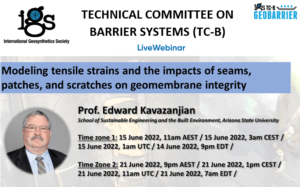TC-Barriers Webinar: Modeling tensile strains and the impacts of the seams, patches, and scratches on geomembrane integrity
About the webinar:
Excessive tensile strains present a significant threat to geomembrane integrity. Advanced numerical models enable a design engineer to explicitly model waste-liner system interaction in order to calculate the nominal tensile strains in high-density polyethylene (HDPE) geomembrane liners subject to static and seismic loads. However, strain concentrations due to seams and scratches perpendicular to the induced tensile strain in the geomembrane can amplify the nominal tensile strain by a factor of 4 or more. Closed-form solutions must be used to incorporate these strain concentrations into the performance assessment.
Analysis of the performance of landfills where tears were observed in the geomembrane liner following an earthquake illustrates the importance of considering tensile strain concentrations in evaluating liner system performance. The closed form factors used to evaluate these strain concentrations were validated experimentally using uniaxial wide-width tensile testing and digital image correlation. The potential for long-term development of tensile strains in HDPE geomembrane liners in landfills was investigated via numerical analysis using a new constitutive model for municipal solid waste (MSW) that incorporates both mechanical creep and biodegradation. The influence of the friction angle of the liner system interfaces, the biodegradation of MSW, and the MSW filling rate on nominal tensile strains were investigated using this model. Results of these analyses provide insight on measures that can be taken to mitigate tensile strain development in geomembrane liner systems for landfills.
About the speaker:
Edward Kavazanjian is a Regents Professor and the Ira A. Fulton Professor of Geotechnical Engineering in the School of Sustainable Engineering and the Built Environment in the Ira A. Fulton Schools of Engineering at Arizona State University. Professor Kavazanjian’s expertise includes geotechnical engineering for civil infrastructure systems, design and construction of waste containment systems, geotechnical earthquake engineering, the mechanical properties of solid waste, and the emerging field of biogeotechnical engineering. He is recipient of the 2009 Ralph B. Peck Award, 2010 Thomas A. Middlebrooks Award, and the 2011 Terzaghi Award from the American Society of Civil Engineers (ASCE). In 2013, he was elected to the National Academy of Engineering for his work on landfills and geotechnical earthquake engineering. In August 2015, he became Director of the Center for Bio-mediated and Bio-inspired Geotechnics (CBBG), a National Science Foundation-funded Gen-3 Engineering Research Center dedicated to the emerging sub-discipline of biogeotechnical engineering. In 2018, he was elected a Distinguished Member of ASCE and is past-president of the ASCE Geo-Institute and the US University Council for Geotechnical Education and Research (USUCGER).
Registration:
Time zone 1: 15 June 2022, 11am AEST / 15 June 2022, 3am CEST / 15 June 2022, 1am UTC / 14 June 2022, 9pm EDT:
https://us06web.zoom.us/webinar/register/WN_MTRQPjOZTXSzGcRz2kF4Gg
Time Zone 2: 21 June 2022, 9pm AEST / 21 June 2022, 1pm CEST / 21 June 2022, 11am UTC / 21 June 2022, 7am EDT:
https://us06web.zoom.us/webinar/register/WN_N6YWlqoNQgSBoE0-wjP03Q



















